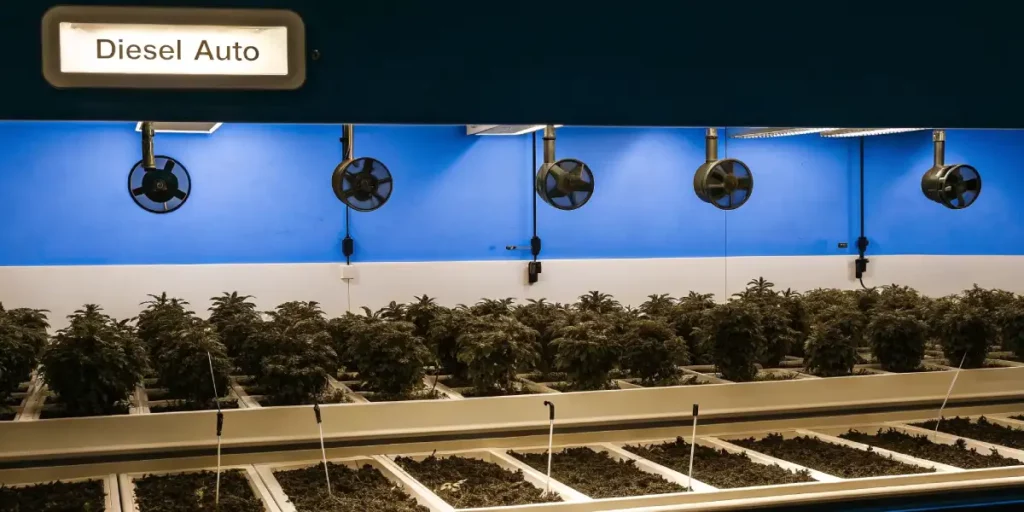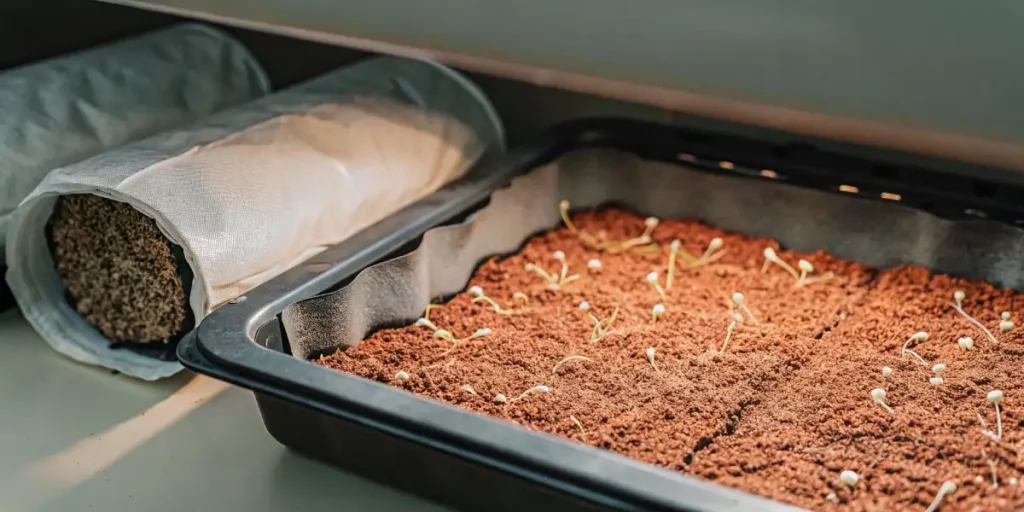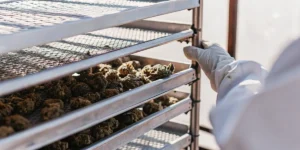Diesel auto strains are renowned for their unique diesel fuel aroma and rapid growth, making them a favorite among both novice and experienced cannabis growers. They are autoflowering, meaning that they transition from vegetative growth to the flowering stage with age rather than changes in the light cycle. This characteristic makes it a resilient and straightforward choice for growers looking to simplify the cultivation process while still yielding impressive results.
To start growing, it is crucial to choose the right seeds from a reputable source to ensure genetic reliability and quality. Once you have secured your seeds, germination is the next step. The paper towel method is popular and effective: place your seeds between damp paper towels and keep them in a warm, dark area. Within 1–4 days, the seeds should begin to sprout, showing small white roots.
Once germinated, it’s time to plant your seeds in a suitable growing medium. These strains adapt well to various media, including soil, coco coir, and hydroponic systems. Plant your sprouted seeds root-down about 1 cm deep into the medium. Ensure the growing area is adequately lit—ideally, using LED grow lights can provide the optimal brightness and spectrum for rapid cultivation.
After planting, maintaining the right environmental conditions is essential. These plants thrive in temperatures between 20–25°C (68–77°F) with a relative humidity of 40–50%. Consistency is key, so strive to maintain these conditions using a combination of fans, humidifiers, and heaters if necessary. Additionally, feed your plants a balanced nutrient solution specifically formulated for cannabis, following a schedule tailored to the autoflowering growth cycle.
Finally, it’s crucial to monitor your plants for signs of pests or diseases, especially as they begin to flower. Common issues include spider mites and powdery mildew, which can be managed with natural or chemical treatments if caught early. Most autoflowering strains require 8–10 weeks from germination to harvest, at which point the buds should be dense, aromatic, and ready to enjoy. With attention to detail and diligent care, growing this type of cannabis can yield a plentiful and rewarding harvest.
Overview: Traits, Effects & Genetics
The Diesel Auto strain is a compelling choice for cannabis growers and enthusiasts looking for a robust yet manageable plant. This autoflowering variant of the classic Diesel strain is recognized for its unique, pungent aroma reminiscent of diesel fuel, hence its name. It produces compact and dense buds that are rich in resin, making it an attractive option for those interested in resin extraction or producing concentrates. A highlight for cultivators is its fast flowering cycle, typical of autoflowering strains, with a full growth period that can be as short as 8–9 weeks from seed to harvest.
This strain is renowned for its distinctive effects that balance both physical relaxation and cerebrally uplifting experiences. The effects often start with an energizing, euphoric high that stimulates creativity and sociability, making it suitable for daytime use. As the high progresses, it gradually promotes a calming and relaxing sensation throughout the body. This duality makes it an excellent choice for users seeking a balanced psychoactive experience that can aid both recreational activities and stress relief. It is also noted for its potential therapeutic benefits, such as alleviating anxiety, depression, and physical pain.
Genetically, it is a hybrid that combines the original Diesel’s potent genetics with ruderalis to introduce the autoflowering characteristic. This blend results in a stable plant that inherits the strong and aromatic profile of its Diesel lineage while benefiting from the autoflowering capabilities offered by ruderalis, such as resilience and quicker lifecycle. This strain is typically sturdy and can thrive in various growing conditions, from indoor setups to outdoor gardens, making it an ideal option for both novice and experienced growers who seek a low-maintenance cultivation experience.
Optimal Environment to Grow Diesel Auto Successfully
Growing Diesel Auto, an autoflowering cannabis strain renowned for its unique diesel aroma and robust growth, demands careful attention to environmental conditions to ensure a thriving plant. Similarly, cultivating the Corkscrew Auto Tyson S strain requires maintaining ideal temperature ranges to maximize its potential. Both strains thrive best in a mild climate, with temperatures ranging between 68°F to 77°F (20°C to 25°C) during the day. It is essential to maintain this range to prevent stress that could hinder the plant’s growth and cannabinoid production. Night temperatures should not drop below 59°F (15°C) to avoid shocking the plant.
Lighting plays a pivotal role in the growth of autoflowering cannabis. Since it does not rely on light cycles to start flowering, it benefits from a stable 18 to 24-hour light schedule to maximize its yield potential. Growers typically use LED or fluorescent lighting to provide sufficient illumination and energy efficiency. Ensuring the light is evenly distributed across the plant canopy will help promote uniform growth and robust bud development. Adjusting light intensity and distance as the plant matures can optimize photosynthesis and increase yields.
Humidity control is another vital aspect of creating an optimal environment. During the vegetative phase, keep humidity levels between 50% and 60% to prevent excessive transpiration and encourage rapid growth. As the plant transitions into the flowering period, gradually reduce humidity to around 40% to 50%, minimizing the risk of mold and mildew, which could compromise the quality and quantity of the harvest. Using oscillating fans can help maintain proper air circulation, further reducing humidity-related issues.
Proper soil and nutrient management are essential for the health and productivity of autoflowering cannabis. Utilize a well-draining soilless mix or quality potting soil amended with perlite to ensure adequate aeration and prevent root rot. These plants benefit from a balanced nutrient regimen tailored to their life cycle stages. During the vegetative phase, a nitrogen-rich fertilizer will support lush leafy growth, while in the flowering stage, a phosphorus and potassium-rich formula will enhance bud production and potency. Regularly monitor pH levels, aiming for a range of 6.0 to 7.0, to ensure optimal nutrient absorption.

Grow Room Setup for Diesel Auto Plants
Setting up a grow room for Diesel Auto plants requires meticulous attention to detail to ensure optimal growth and robust yields. This popular strain, known for its fast flowering and potent effects, thrives in controlled environments. Begin by designating a secure space that can be easily maintained. A room or closet with a minimum area of 1 square meter is recommended to provide ample space for the plants to grow and enable easy access for maintenance.
Lighting is a crucial factor in the success of cultivation. Due to their auto-flowering nature, these plants will transition from the vegetative to the flowering stage without changes in the light cycle. Opt for LED grow lights, which are energy efficient and provide a full spectrum of light necessary for the plants’ development. A light schedule of 18 hours on and 6 hours off is typically effective for maximising growth, although some growers maintain a 20 hours on, 4 hours off light schedule throughout the lifecycle.
Temperature and humidity control are vital for maintaining a healthy grow environment. These plants thrive in temperatures between 20–25°C (68–77°F) during their light period and slightly cooler nocturnal temperatures of 15–21°C (59–69°F). The humidity should ideally be kept between 40–60% during vegetative growth and reduced to 30–40% during flowering. Investing in thermostats and hygrometers along with fans and ventilation systems ensures consistent climate control and helps to prevent mold and pests.
When setting up the growing medium and nutrients, consider using a high-quality soil mix or coco coir to foster root development. Auto-flowering strains often require less nutrients than their photoperiod counterparts, so starting with a balanced nutrient solution suitable for all stages can prevent nutrient burn. Always have a pH meter on hand to monitor and adjust the pH levels of your water and nutrient solutions to between 6.0 to 7.0 for soil, and 5.5 to 6.5 if using hydroponics.
Finally, ensure proper ventilation and air circulation within the grow room to enhance plant transpiration and CO₂ absorption, contributing to vigorous plant growth. Install exhaust fans to eliminate excess heat and carbon dioxide buildup, and oscillating fans to promote airflow and strengthen plant stems. By carefully managing these aspects, your grow room setup will lay a solid foundation for achieving a successful and fruitful harvest.
Indoor Growing Tips for Diesel Auto
Growing Diesel Auto indoors can be greatly rewarding, as it’s a resilient strain that offers potent yields in a short time. The key to success with this strain is knowing its autoflowering nature, which means it transitions from vegetative growth to the flowering stage without varying light schedules. This characteristic simplifies the cultivation process, allowing even novice growers to achieve excellent results. By providing optimal conditions, you can enhance both the growth rate and the quality of the final harvest.
Firstly, to maximize its potential, ensure consistent lighting. While this strain doesn’t require the traditional 18/6 or 12/12 light cycle changes due to its autoflower genetics, maintaining a stable 18 to 20 hours of light per day can boost growth efficiency. Consider using LED grow lights as they create a balanced spectrum, are energy-efficient, and maintain lower temperatures, which is ideal for managing the microclimate in your growing space.
Temperature and humidity control are also crucial for successful indoor cultivation. Aim to keep your grow room’s temperature around 70 to 80 degrees Fahrenheit during the day and not drop more than 10 degrees at night. Utilizing a humidifier to maintain humidity levels between 40% to 60% during the vegetative phase and lowering it to 30% to 40% during flowering will help prevent mold and pests. Keeping an oscillating fan for air circulation further promotes sturdy plant growth and avoids microclimates.
Nutrient management is another pivotal aspect of raising healthy plants. Given their short life cycle, autoflowers require a precise nutrient regimen to support rapid developmental stages. Begin with a nitrogen-rich plant food during the initial growth phase, transitioning to a phosphorus and potassium-focused formula as they start to flower. Be cautious with nutrient delivery, as autoflowering strains can be sensitive to overfeeding; starting with half-strength solutions is generally advisable.
Regular inspection for pests and diseases is imperative, even when growing indoors. These plants are less susceptible to such issues compared to outdoor counterparts, but vigilance is still necessary. Implement organic pest control measures and ensure cleanliness in your grow area to mitigate these risks. Pruning and training techniques such as low-stress training (LST) can be beneficial for optimizing light exposure and encouraging bushier growth forms. If you’re cultivating a vigorous strain like Sour Diesel, proper training and pest prevention are especially important to maintain healthy, high-yielding plants.
Overall, cultivating Diesel Auto indoors allows for a high degree of control over environmental factors, leading to a more predictable and fruitful yield. By adhering to these fundamental tips, you can ensure a thriving grow space that capitalizes on the unique advantages this strain offers. Happy growing!
Outdoor Growing Tips for Diesel Auto
Diesel Auto is a popular autoflowering strain among cannabis enthusiasts, known for its robust growth, aromatic presence, and potent effects. When considering outdoor cultivation, this strain offers unique benefits due to its resilience and fast life cycle. Unlike photoperiod strains, this autoflowering variety starts flowering automatically based on age rather than light cycles, making it ideal for growers in various climates. Proper preparation and care can yield rewarding results for outdoor farmers. The first step is selecting the right location, ensuring the plants get ample sunlight, which is crucial for healthy growth.
Choosing the right soil is paramount for cultivating autoflowers outdoors. Cannabis, particularly autoflowering varieties, thrives in well-draining, nutrient-rich soil. Consider starting with a mix that includes components like perlite and vermiculite to enhance drainage and aeration. It’s equally important to maintain suitable pH levels in the soil, ideally between 6.0 and 7.0, to facilitate optimal nutrient absorption. Regularly test and amend the soil as needed to correct any imbalances. Using organic fertilizers can benefit the plants by providing a steady flow of nutrients without overwhelming them.
Watering practices also play a significant role in the successful outdoor cultivation of autoflowering strains. Due to their quick flowering time, generally between 8 to 10 weeks, these plants require consistent moisture while avoiding overwatering. Inconsistent watering schedules can lead to stress and reduced yields. Monitor local weather conditions to anticipate dry spells or rainstorms, adjusting your watering routines accordingly. Implementing mulching techniques can also help retain soil moisture and regulate temperature, providing a more stable environment for growth, especially during hot weather.
Pest and disease management should not be overlooked when growing autoflowers outdoors. While these strains can be hardy, they are still susceptible to pests such as aphids, spider mites, and caterpillars, as well as diseases like powdery mildew and botrytis. Regularly inspect plants for any signs of these issues. Employ preventative measures such as companion planting, organic pesticides, and beneficial insects to protect your crop. Additionally, ensuring proper spacing and airflow around each plant will help minimize the risk of mold and disease, promising a healthier and more bountiful harvest.
How to Germinate & Propagate Diesel Auto
To successfully cultivate Diesel Auto, an autoflowering strain of cannabis, it’s crucial to understand the germination process. Start by soaking your seeds in a glass of water for 24 hours to hydrate them and initiate the germination process. This step is vital as it provides the seeds with enough moisture to crack their hard outer shell. Once the seeds have absorbed sufficient water, they should sink to the bottom, indicating they are ready for the next step.
After soaking, transfer the seeds to a damp paper towel. Carefully place the seeds between two layers of the towel and ensure it is moist but not soggy to avoid mold growth. Place this setup inside a plastic bag or place it on a tray covered with an upside-down plastic dome to maintain humidity. Store them in a warm, dark place with temperatures between 70-85°F (21-29°C). Within 24-48 hours, you should see small white root tips emerging, indicating successful germination.
Once the seeds have sprouted, gently plant them in a small container filled with a light potting mix or a seed starter. Make a small hole about half an inch deep, carefully place the seedling root down, and cover it lightly with soil. Keep the soil moist but not waterlogged and place under a light source to encourage growth. These strains typically require less attention due to their autoflowering nature, making them ideal for beginners. Ensure to provide adequate light, water, and nutrients for a healthy propagation process.
Propagation can also involve cloning, although it’s less common due to the autoflowering characteristics. Take cuttings from a healthy mother plant, but note that due to the set lifecycle of autoflowers, clones do not grow larger or deviate from the genetic timeline of the original seed. Be sure to use sterile tools and rooting hormone to increase success rates. Knowing these processes will give you a healthy start in growing autoflowering cannabis.
Vegetative Stage: Nurturing Your Diesel Auto Plants
The vegetative stage is a critical phase in the growth cycle of diesel auto cannabis plants. During this period, your plants focus on developing strong and healthy structures that will support the later phases of growth. This stage typically lasts for about 3-4 weeks, although it can slightly vary based on the specific strain and growing conditions. During this time, it’s important to prioritize optimal conditions to ensure your plants can thrive. Providing the correct light, nutrients, and environment are key factors that will influence the overall health and yield of your cannabis plants.
One of the most important aspects of the vegetative stage is lighting. Autoflowering strains have specific light requirements that differ from regular photoperiod strains. A consistent light cycle of 18 to 24 hours per day is often recommended to encourage vigorous growth. This extended exposure to light supports the rapid development of leaves and stems, which are essential for capturing energy and supporting the plant’s needs during flowering. Make sure your setup maintains adequate light intensity; LED and full-spectrum lights are excellent choices for providing the necessary illumination without generating excessive heat.
Nutrient management is another vital component of nurturing your plants during the vegetative stage. A balanced nutrient regimen including nitrogen, phosphorus, and potassium (N-P-K ratio around 2-1-1) supports the rapid growth typical of this stage. Trace elements such as calcium and magnesium are also important for overall plant health. It’s crucial to assess the soil pH level, keeping it between 6.0 and 7.0, to ensure nutrient absorption. Over-fertilization should be avoided as it can lead to nutrient burn, negatively affecting growth.
Environmental conditions play a pivotal role in the vegetative stage. Maintaining a temperature range between 70-85°F (21-29°C) during the day and slightly cooler temperatures at night promotes optimal growth rates. Humidity levels should be kept within 40-70% to prevent issues such as mold or mildew. Adequate air circulation is also essential to avoid stagnation and pest infestations, while promoting sturdy stem development. Regular inspection of your plants will help in early identification and management of any potential issues such as pests or diseases, ensuring a healthy progression into the flowering stage.
Proper care and attention to the details of the vegetative stage set the foundation for a successful flowering period. By focusing on the right light conditions, nutrient balances, and environmental factors, your cannabis plants can develop strong roots and shoots, fostering resilience and an eventual rewarding harvest. This stage is a testament to the importance of patience and diligence in cannabis cultivation.

Flowering diesel auto: What to Expect
When cultivating diesel auto cannabis plants, one of the most exciting phases is the flowering stage. This period is when the plants start to develop buds and produce the distinctive diesel aroma they are famous for. Typically, these plants begin to flower approximately 3–4 weeks after germination, thanks to their autoflowering genetics. These genetics allow them to transition to the flowering stage regardless of light conditions, making them an attractive option for both novice and experienced growers.
During the flowering stage, you can expect significant changes in your cannabis plants. The development of trichomes, the tiny, resinous glands on the surface of the buds and leaves, becomes prominent. These trichomes are responsible for the plant’s potency and rich aroma. As the flowers mature, you’ll observe the elegant hues of pistils starting to redden and darken, signalling the plant’s ongoing maturation. Enhanced resin production also begins, with trichomes turning milky white, then amber as they mature, indicating peak potency.
It’s important to pay close attention to nutrient needs during flowering as well. These strains may require a boost in phosphorus and potassium to support bud development. However, be cautious of overfeeding, as autoflowering varieties can be more sensitive to nutrient excesses. Regularly inspect your plants for any signs of nutrient burn or deficiency, and adjust your feeding regimen accordingly. Ensuring your plants receive adequate water, light, and nutrients during this stage will result in healthier and more prolific flowering.
As your plants approach the end of their flowering period, usually around 8–10 weeks from germination, prepare for harvest. You’ll notice the buds are dense, sticky, and exude a strong diesel scent, a hallmark of this strain. The visual cues for harvest readiness include darkened pistils and fully developed trichomes. Investing in a magnifying tool can be helpful for examining trichome coloration closely. At this stage, the anticipation of your hard work culminates in a rewarding harvest of aromatic and potent buds.
Feeding diesel auto: Fertilizers & Nutrient Schedule
Diesel auto, as a variety of autoflowering cannabis, requires a tailored approach to feeding due to its compact growth cycle and unique metabolic needs. The key to successful fertilization lies in knowing the timing and types of nutrients needed throughout a plant’s lifecycle. During the initial 2–3 weeks, seedlings do not demand heavy feeding. Instead, they thrive on a modest amount of a balanced starter nutrient mix, ensuring the foundational growth of roots and stems.
As the plant moves into the vegetative phase, which lasts around 4 weeks, increasing nutrients becomes essential. At this stage, more nitrogen is required to support the development of lush foliage. A potent growth fertilizer with a high nitrogen content will stimulate robust and vigorous growth. However, it is vital to avoid over-fertilization; too much nitrogen can lead to nutrient burn, making it imperative to follow a calculated feeding schedule, starting with a half-strength dosage and gradually adjusting based on plant response.
In the flowering phase, typically commencing in the fifth week, nutrient requirements shift significantly. Higher levels of phosphorus and potassium are needed to boost flower formation. Switching to a bloom-focused nutrient mix, rich in these elements, encourages the production of larger, more potent buds. Monitoring pH levels during each feed is crucial to ensure nutrient uptake efficiency, ideally maintaining a slightly acidic environment for soil (around 6.0–6.5) and hydroponics (5.5–6.0).
Regularly consulting a professional feeding schedule tailored for autoflowering strains helps keep nutrient regimens consistent and effective. Using tools such as EC meters can help gauge the precise nutrient concentration, allowing growers to fine-tune feedings accurately. Recognizing the plant’s development stages and adjusting the nutrient balance accordingly can lead to maximized yields and high-quality harvests, showcasing the strain’s full potential.
Pest and Disease Prevention for Healthy Cannabis Plants
Growing Diesel Auto cannabis plants can be a rewarding endeavor, yet maintaining the health of these plants requires vigilance against pests and diseases. One of the critical strategies in pest prevention is maintaining a clean growing environment. Ensure that the growing area is free from debris and fallen leaves can reduce the instances of pests like aphids, spider mites, and whiteflies. Regular cleaning, along with proper ventilation, limits the hospitability of the environment to these nuisances. Additionally, the use of sterile soil, tools, and containers minimizes the risk of disease-causing pathogens entering the growing space.
Companion planting and natural predators are effective ways to keep pests at bay without resorting to chemicals. Beneficial insects, such as ladybugs and predatory mites, can be introduced to control pest populations naturally. Meanwhile, planting companion plants like marigolds, basil, or dill, known to repel certain pests, can enhance your cannabis plants’ defenses. These methods not only prevent infestations but also promote a biodiverse ecosystem that supports healthy plant growth.
Implementing a robust monitoring routine is crucial in identifying early signs of pest and disease issues. Regular inspection of leaves and stems for discoloration, spots, or webbing ensures that any problems are caught early. Should pests be detected, organic treatments such as neem oil or insecticidal soap can be used to protect the plants without harming the environment. In the face of disease, removing affected parts of the plant promptly can prevent the spread to healthy areas.
Moreover, maintaining optimal growing conditions plays an essential role in both pest and disease prevention. Cannabis plants thrive in well-managed environments where temperature and humidity are controlled to prevent mold and fungal diseases. Humidity levels should be kept low during the flowering stage to reduce the risk of bud rot. Constant adjustments based on the plant’s growth stage will aid in keeping the plants robust and resistant to external threats.
For those cultivating autoflowering strains, a proactive approach in pest and disease management can significantly affect the quality and yield of the cannabis plants. By using a combination of preventive vigilance, natural defenses, and controlled environment strategies, growers can maintain healthy plants that thrive, resulting in high-quality yields. Consistent monitoring and adaptations in treatment strategies over the growing cycle ensure that the plants remain resilient and productive.
Harvesting & Drying Diesel Auto the Right Way
Harvesting and drying Diesel Auto, an autoflowering strain renowned for its potent diesel-like aroma and high THC content, is a crucial step that requires careful timing and preparation. The first indicator that your plants are ready for harvesting is the appearance of the trichomes. When most of the trichomes appear milky white, with a few turning amber, it’s an ideal time to harvest. It’s important to also observe the pistils; they should be about 70% to 90% darkened and curled inwards. Harvesting at this precise moment will ensure optimum potency and flavor.
Before you begin the harvest, it is wise to stop watering your plants a couple of days in advance. Doing so allows them to expend any excess moisture and nutrients, paving the way for a smoother drying process. Cut your plants in the early morning or just after the lights turn on, as they tend to have more moisture and potency at this time. Using sanitized scissors, carefully cut branches close to the base, ensuring you minimize any damage to the buds. Handle the buds with care to preserve the delicate trichomes that hold the plant’s resin.
Once harvested, the drying process should commence immediately to prevent mold and ensure quality preservation. Hang the branches upside down in a dark room with controlled humidity levels of around 50% and temperatures between 18 to 21 degrees Celsius. This environment will facilitate even drying, which typically takes about 7 to 10 days. Make sure to ensure adequate air circulation, but avoid direct airflow onto the buds, as this can result in excessive dryness and a loss of potency.
After the initial drying phase, it’s essential to cure the buds for the best flavor and smoothness. Place the dried flowers into airtight jars, filling them about three-quarters full, which allows for some air circulation. Store these jars in a cool, dark place, opening them for a few minutes a day to release any built-up moisture. This process, known as burping, should be done for at least two weeks to optimize the aromatic profile and smoothness of your harvest. Proper harvesting and drying methods ensure that your plants deliver their full potential in both quality and potency.
Diesel Auto Strain Type: Indica, Sativa, or Hybrid?
Diesel Auto is a renowned strain within the cannabis cultivation community because of its unique blend of genetic components. When determining whether it is classified as an Indica, Sativa, or Hybrid, it is essential to consider its lineage. This strain typically falls under the category of a Hybrid. This classification comes from its diverse ancestry, which combines traits from both Indica and Sativa plants. Its hybrid nature allows growers to experience a balance of effects – both stimulating and relaxing, making it a versatile strain suitable for various occasions.
One of the defining characteristics that highlights its Hybrid nature is the growth pattern. While it retains the robust structure associated with Indica strains—typically shorter and bushier—it also exhibits some of the tall and elongated growth common in Sativa varieties. This blend makes it a perfect choice for cultivators seeking an intermediate-sized plant that is manageable yet yields a commendable harvest. The genetic diversity ensures that growers can enjoy the best of both worlds within the cannabis plant kingdom.
Besides its growth attributes, the effects further establish its status as a Hybrid strain. Smokers often report an initial euphoric and uplifting experience typical of Sativa strains, which gradually transitions into soothing and calming sensations characteristic of Indicas. This balanced effect profile makes it particularly appealing to both recreational users seeking a well-rounded high and medical users who benefit from its combined therapeutic properties. Overall, its Hybrid status offers a comprehensive growing and consuming experience, blending desirable traits from both Indica and Sativa strains.
Why Grow Diesel Auto? Key Benefits for Cultivators
These autoflowering strains offer cultivators a unique blend of advantages that make them a popular choice among both novice and experienced growers. Originating from the famed Diesel lineage, this variety brings together robust genetics and autoflowering capabilities, resulting in a plant that is not only easy to manage but also promises a high-quality yield. One of its standout characteristics is the quick growth cycle, allowing cultivators to enjoy multiple harvests in a single growing season. This rapid turnover is particularly beneficial for those looking to maximize production in limited time frames, making it an ideal choice for commercial operations as well as personal growth setups.
Another key benefit of growing this strain is its resilience and adaptability. Its genetics are known for their hardiness, allowing it to thrive in varying environmental conditions, from indoor to outdoor settings. This versatility reduces the need for intensive care and attention, which is advantageous for cultivators with limited resources or those new to cannabis growing. Moreover, these plants typically exhibit robust resistance to pests and diseases, further simplifying the cultivation process and increasing the likelihood of a healthy, bountiful harvest.
The final significant advantage lies in its exceptional aroma and potency. The strain maintains the characteristic pungent, fuel-like aroma of its Diesel lineage, which is highly sought after in the cannabis market. Additionally, it often boasts significant THC levels, delivering a potent effect that appeals to both recreational and medicinal users. This combination of strong, pleasant aroma and high potency makes it a favored option for cultivators looking to produce top-quality cannabis. Overall, the array of benefits provided by this autoflowering variety makes it a valuable addition to any cultivator’s garden.
Potential Challenges When Growing Diesel Auto
Growing Diesel Auto cannabis can be both a rewarding and challenging experience. One of the primary challenges growers might face is controlling the plant’s size. Although this autoflowering variety generally remains compact, inexperienced growers might find it tricky to manage space limitations effectively. Inadequate space management can potentially lead to overcrowding, which can hinder airflow and increase the likelihood of mold and mildew development. This challenge is particularly significant for indoor growers who must optimize their growing environment to ensure healthy development.
Another common issue is ensuring consistent light schedules. These plants automatically switch from the vegetative phase to the flowering phase based on time rather than light exposure. However, they still require a substantial amount of light to maximize growth. One should aim for at least 18–20 hours of light per day, as inadequate lighting can significantly slow down growth and decrease yield. Ensuring that your plants receive consistent and adequate lighting can be tricky, especially for those who grow outdoors and depend on natural sunlight.
Ensuring optimal nutrient levels is yet another challenge. These autoflowering strains are known for robust growth, which demands a proper balance of nutrients to support their rapid lifecycle. Nutrient deficiencies or excesses can quickly manifest due to their short life spans. It’s crucial for growers to monitor and adjust nutrient intake carefully. Specifically, autoflowers are often more sensitive to nutrient overfeeding, necessitating a more cautious approach to fertilization compared to photoperiod strains.
Pest control is also a significant concern. The plant’s compact and dense structure makes it an inviting target for pests like spider mites, aphids, and caterpillars. These pests can cause extensive damage if not identified and managed swiftly. As such, growers need to maintain a vigilant inspection routine and consider integrating natural pest deterrents or other organic pest control methods to shield their crops from potential infestations.
Finally, a challenge that might arise is the plant’s rapid growth schedule. The swift transition from seed to harvest means there’s a smaller window for correcting any mistakes or environmental inadequacies. Growers must act promptly when issues arise, as there’s limited time to correct problems before they impact the yield significantly. This rapid lifecycle demands a proactive and well-prepared approach, making it crucial for growers to have a solid knowing of the plant’s needs from the onset.

Is Diesel Auto Worth Buying? Here’s What You Need to Know
Diesel Auto, a popular strain within the cannabis community, is known for its unique aroma and robust effects. It is a type of autoflowering cannabis, meaning it automatically flowers based on age rather than changes in light cycles. This makes it an attractive option for growers looking for simplicity and speed, without having to worry about complicated light schedules. Originating from the legendary Diesel strains, this autoflowering variety inherits a distinct, pungent aroma reminiscent of fuel, which many enthusiasts find particularly compelling.
Aside from its appealing scent, this strain is favored for its balanced effects. It typically offers a potent yet clear-headed high, suitable for both recreational and medicinal users. It tends to provide uplifting and energizing sensations, making it a popular choice for daytime use. For those seeking relief, it may help alleviate symptoms associated with stress, anxiety, and depression due to its mood-enhancing qualities. Its relatively moderate THC levels, ranging between 14% to 20%, make it accessible for both new and experienced users.
From a cultivation standpoint, it is considered a forgiving strain, suitable for novice and seasoned growers alike. Its autoflowering genetics allow it to transition from the vegetative to flowering stage swiftly, with a typical lifecycle of 8–10 weeks. This rapid growth allows for multiple harvests within a single growing season. Furthermore, it’s resilient and adjusts well to various growing conditions, whether indoors, outdoors, or in a greenhouse—making it a versatile option for growers with limited experience.
In terms of yield, while it may not produce the largest harvests compared to photoperiod strains, it compensates with greater ease of cultivation and fewer requirements. Indoor growers can expect moderate yields of compact, resin-rich buds, and its smaller stature ensures it fits comfortably in smaller grow spaces. Additionally, its hardiness against common pests and diseases makes it a reliable choice for those looking to minimize the risks involved in cannabis cultivation.
FAQs
How long does it take to grow the Diesel Auto strain from seed to harvest?
The Diesel Auto strain typically completes its lifecycle in just 8 to 10 weeks from seed to harvest. Thanks to its autoflowering genetics, it transitions from the vegetative to flowering stage automatically, regardless of light schedule. This short, predictable growth cycle makes it ideal for growers looking to achieve multiple harvests per year.
What are the ideal growing conditions for the Diesel Auto strain?
Diesel Auto thrives in mild temperatures between 68°F and 77°F (20°C–25°C) with humidity levels around 50%. It performs best under consistent lighting—typically 18 to 20 hours per day for indoor setups. Whether you grow Diesel Auto indoors or outdoors, maintaining proper ventilation and balanced nutrients is essential for maximizing yield and resin production.
Can I grow the Diesel Auto strain outdoors, and what should I consider?
Yes, the Diesel Auto strain grows very well outdoors, particularly in sunny, temperate climates. Choose a location with full sun exposure and well-draining soil rich in organic matter. Protect plants from heavy rainfall and pests by using natural barriers or organic pest control. Since it flowers automatically, timing your planting can help ensure harvest before cooler weather sets in.
What nutrients does Diesel Auto cannabis need for best results?
During the vegetative stage, the Diesel Auto strain benefits from nitrogen-rich nutrients to support strong foliage and stem growth. As the plant enters flowering, shift to a bloom formula higher in phosphorus and potassium to promote bud density and potency. Always maintain soil pH between 6.0 and 6.5 to ensure efficient nutrient uptake, and avoid overfeeding since autoflowers are sensitive to nutrient excess.
How can I increase the yield and potency of my Diesel Auto plants?
To boost the yield and potency of Diesel Auto cannabis, ensure consistent lighting and environmental control throughout the grow cycle. Techniques like low-stress training (LST) can help improve light penetration and airflow, encouraging more bud sites. Regular monitoring of temperature, humidity, and nutrient balance—along with a proper drying and curing process—will maximize both quantity and quality in your final harvest.





